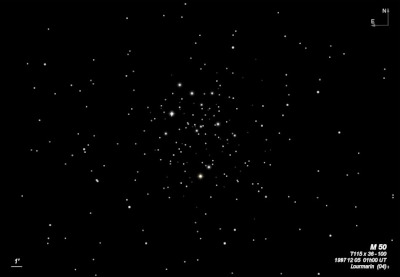
Giovanni Domenico Cassini possibly discovered M50 = NGC 2323 = h425 around 1711. Charles Messier independently discovered the cluster on 5 Apr 1772. William Herschel described the cluster (unpublished) on 4 Mar 1785 (sweep 377) as "a very brilliant cluster of large stars, considerably compressed and rich, above 20' in diameter, the stars of various sizes, visible in the finder."
300/350mm - 13.1" (3/24/84): ~75 stars including some brighter stars at the south and northeast borders. There are a few dense spots and many stragglers. An orange/red mag 8 star is at the south edge and a nice 16" pair of mag 9/11 stars (h748) is 1' NW. There is an elongated 4'x3' region that is devoid of stars just north of the colored mag 8 star. Located 42' E of mag 6.0 HD 52312.
400/500mm - 18" (3/15/10): very bright, fairly scattered cluster, though contains a richer subgroup. About 125-150 stars were resolved at 175x in the central 10'-12'. The cluster has roughly a triangular or wedge-shaped outline, highlighted by an 8' string of stars oriented ~E-W on the north side (including mag 9.0 HD 52965) and a longer 10' string oriented NW-SE on the SW side that includes the brightest cluster star - distinctly orange mag 7.8 HD 52938 near the SE end of the string. Along this string are also four easy pairs of stars. There is a rich circular group of stars, ~5' diameter, a little north of center. On the east side of the cluster is an unequal double, h748 = 8.5/11 at 15". A faint, unequal pair of stars, BRT 392 = 11.5/11.6 at 4", is due west of the unequal pair by 3.5' at the edge of the rich group of stars. A number of stragglers extend out the cluster increasing the size significantly and a scattered group with some brighter stars including mag 9.0 HD 52720 appears detached to the NW.
Notes by Steve Gottlieb